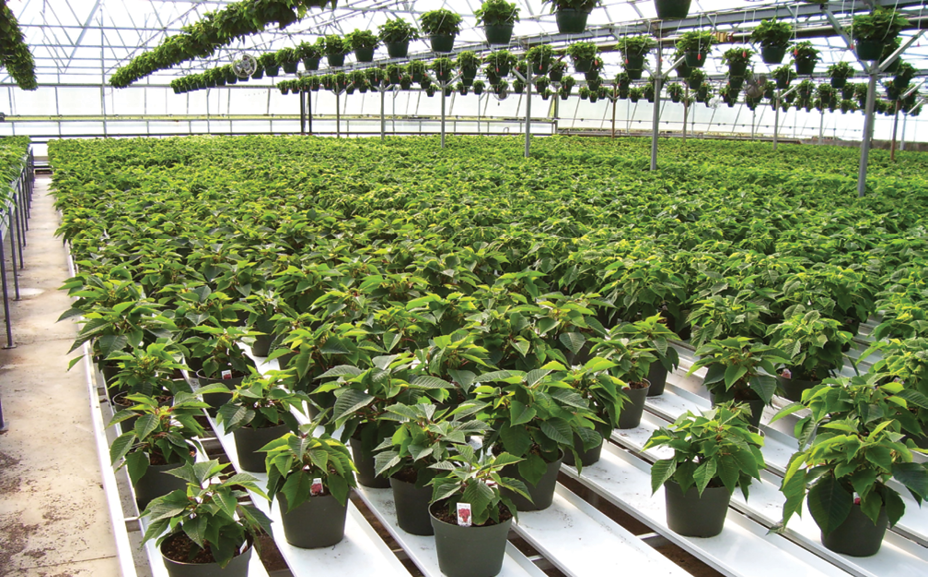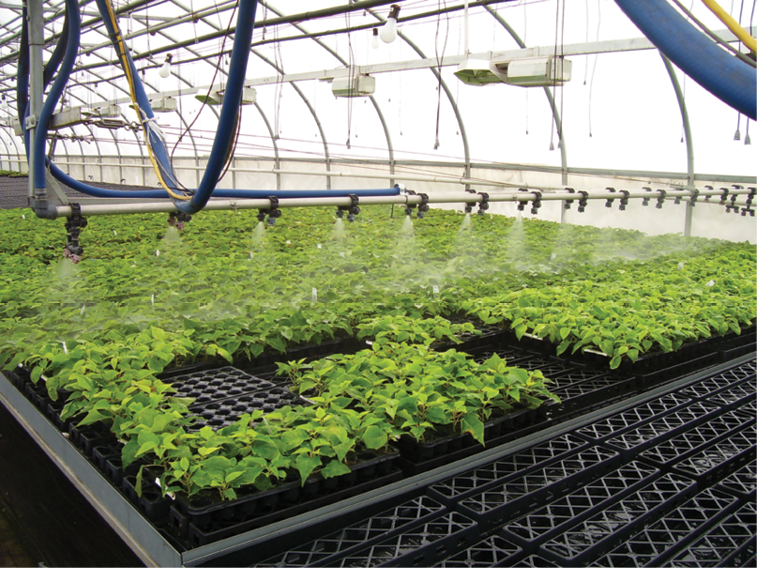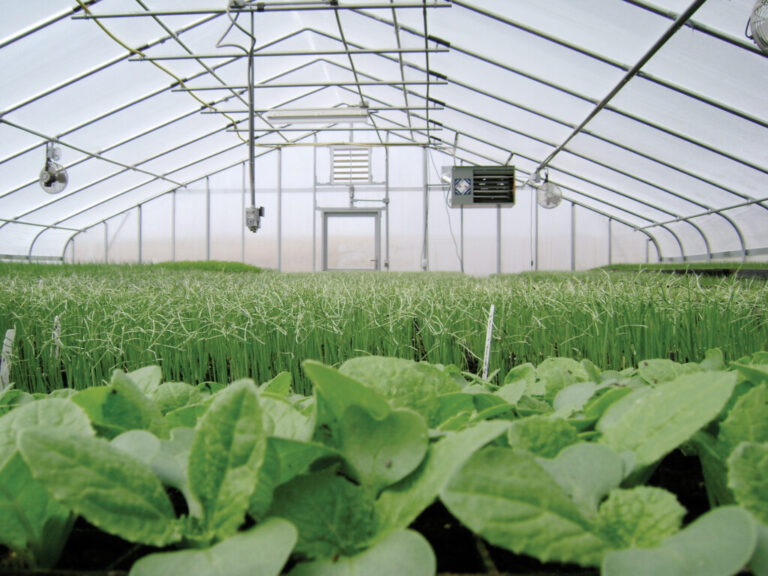To keep your plants healthy and thriving, ensure you have a solid watering system in place for your greenhouse. Here’s a general guide to help you design and implement a greenhouse irrigation system:
Drip Irrigation System:
- Install a drip irrigation system with a mainline and submains.
- Use drip emitters to deliver water directly to the base of each plant.
Water Source:
- Connect the system to a reliable water source like tap water or a dedicated water tank.
Automation:
- Use a timer or controller to automate watering schedules.
Components:
- Mainline, submains, drip emitters, and connectors.
Installation:
- Lay out the mainline and sub mains based on the greenhouse layout.
- Attach drip emitters to deliver water to plants.
Maintenance:
- Regularly check for leaks and clogs.
- Flush the system periodically.
Introduction to Greenhouse Irrigation Setup

As a greenhouse enthusiast, you understand that proper irrigation is the heartbeat of a thriving garden under your care.
It’s not just about giving plants a drink; it’s about providing the right amount at the right time. Let’s delve into why this matters so much.
Now, picture this: You’re tending to your greenhouse, and each drop of water you provide becomes a catalyst for the health and growth of your precious plants. Efficient irrigation, where you give them just what they need, can make a world of difference.
Assessing Your Greenhouse Needs
Understanding the Specific Requirements of Your Crops
As the caretaker of your greenhouse, you need to become a keen observer, almost like a detective solving a plant mystery. Take the time to understand the unique needs of each crop under your care.
Water Preferences: Different plants have different thirst levels. Some like it wet, while others prefer a more moderate drink. Get to know your plants individually, almost like discovering their favorite drink orders.
Soil Types: Just as people have different preferences for where they live, plants have preferences for soil types. Some like it sandy, others clayey.
Understanding the soil preferences of your crops helps you tailor your irrigation plan to their liking.
Stage of Growth: Plants, like children, go through various stages of development. A seedling needs a different care routine compared to a mature plant.
Consider each crop’s age and growth stage when deciding how much water to provide.
Seasonal Adjustments: Picture your greenhouse as a theater and the seasons as different acts. Plants may have different water needs during summer than in winter.
Adjust your irrigation plan accordingly, ensuring a blockbuster performance year-round.
Analyzing Environmental Factors (Temperature, Humidity, etc.) Affecting Irrigation Choices
Now, let’s put on our scientist hats and analyze the environment around your greenhouse. The weather outside is not just small talk; it profoundly impacts how you should water your plants inside.
Temperature: Think of temperature as the mood setter for your plants. Think of it like this: some plants enjoy the heat, while others prefer a cooler vibe. Adjust how you water them based on the temperature shifts so your plants are always in their happy place.
Humidity: Humidity is like the moisture level in the air. Some plants thrive in a spa-like environment with high humidity, while others prefer a drier atmosphere. Tailor your irrigation to complement the humidity preferences of your crops.
Ventilation: Plants need fresh air, just like we do. Proper ventilation ensures a healthy exchange of gases. Adjust your watering routine to maintain the right balance, almost like giving your plants a breath of fresh air.
Imagine sunlight as the ultimate energy drink for your plants. They thrive on it, soaking up its power to grow strong and healthy, just like you recharge with your favorite energy drink.
Consider the amount of light each crop receives and adjust your watering schedule accordingly. It’s like providing a snack to keep them energized throughout the day.
Types of Greenhouse Irrigation Systems
Drip Irrigation
Explanation of How Drip Systems Work:
Think of drip irrigation as a custom water delivery service for your plants. It gives them the right amount of water they need, almost like a personalized service for them.
It involves a network of tubes and emitters that precisely drip water at the base of each plant.
Imagine each plant having its own designated water droplet, ensuring efficient and targeted hydration.
Advantages and Disadvantages:
Advantages:
- Water Conservation: Drip systems minimize water wastage by delivering water directly to the root zone.
- Precision: Each plant gets the right amount of water, promoting optimal growth.
- Weed Control: When water goes straight to the plants, there’s less chance for weeds to take over.
Disadvantages:
- Clogging: Emitters can sometimes get clogged, requiring regular maintenance.
- Initial Cost: Setting up a drip system may have a higher initial cost than other methods.
Best Practices for Installation and Maintenance:
- Ensure Proper Design: Plan the layout to guarantee uniform water distribution.
- Regular Checks: Inspect for clogs and leaks and flush the system periodically.
- Filter Installation: Use filters to prevent clogging of emitters.
- Adjustments: Fine-tune the system based on the specific needs of your plants.
Sprinkler Systems
Overview of Sprinkler Irrigation: Sprinkler systems in a greenhouse are like rain showers on demand. They involve overhead pipes with nozzles that spray water over the plants. It’s a more widespread approach compared to drip irrigation.
Suitable Crops and Greenhouse Sizes:
- Suitable Crops: Ideal for crops that benefit from overhead watering, like leafy greens.
- Greenhouse Sizes: Well-suited for larger greenhouses where widespread coverage is needed.
Installation Tips and Potential Challenges:
- Even Distribution: Plan the layout to ensure even water distribution.
- Adjust Nozzle Heights: Tailor the system to accommodate varying plant heights.
Benefits in Water Conservation and Root Health:
- Water Conservation: Sub-irrigation reduces water evaporation, optimizing water usage.
- Root Health: Direct water delivery to roots promotes healthy root development.
Implementing a Sub-Irrigation System in a Greenhouse:
- Use Capillary Mats or Matting: These materials help wick water up to the plants.
- Proper Drainage: Ensure good drainage to prevent waterlogging.
- Monitoring: Regularly check moisture levels and adjust watering accordingly.
These irrigation systems offer different approaches to meet the diverse needs of your greenhouse plants. Choose the one that aligns best with your crop types, greenhouse size, and water conservation goals.
Smart Irrigation Technologies
Sensor-based Systems
How Sensors Can Monitor Soil Moisture, Temperature, and Other Key Factors:
- Soil Moisture Sensors: Imagine having a tiny assistant in the soil that reports when it’s time to water. Soil moisture sensors measure the water content, indicating whether the soil needs hydration.
- Temperature Sensors: These sensors keep tabs on the temperature in your greenhouse. They act like a thermostat, ensuring the conditions are right for your plants.
Integration with Automated Irrigation Systems:
- Sensors are like messengers that convey critical information to the brain of your irrigation system. When soil moisture levels drop, they signal the automated system to start delivering water precisely where it’s needed.
- This integration ensures a dynamic response to changing environmental conditions, providing a tailored watering approach for each plant.
Enhancing Precision and Resource Efficiency:
Precision is the name of the game. With sensor-based systems, you avoid the guesswork. Water is delivered when and where it’s needed, promoting resource efficiency.
By responding to real-time data, these systems prevent overwatering, conserve water resources, and promote the health of your plants.
Automated Timers and Controllers
Benefits of Automation in Greenhouse Irrigation:
- Consistency: Automation ensures a consistent watering schedule, preventing fluctuations that can stress plants.
- Time Efficiency: With automated timers, you free up your time while ensuring your greenhouse stays on a reliable watering routine.
- Optimized Resource Use: Smart controllers analyze environmental factors and adjust watering schedules, optimizing water usage.
Recommendations for Selecting and Installing Timers/Controllers:
- Compatibility: Choose timers/controllers that are compatible with your irrigation system and sensors.
- Ease of Use: Opt for user-friendly interfaces to simplify programming and adjustments.
- Weather-based Features: Consider systems that factor in weather forecasts to tailor watering schedules further.
Examples of User-friendly Smart Irrigation Systems:
- Rain Bird ST8O-2.0 Smart Indoor/Outdoor WiFi Sprinkler/Irrigation System Timer: This system allows remote control via a mobile app and integrates with weather forecasts for smart watering.
- Rachio 3 Smart Sprinkler Controller: Known for its intuitive interface, it adapts watering schedules based on weather conditions and can be controlled through a smartphone.
Incorporating smart irrigation technologies elevates your greenhouse management to a new level of efficiency and precision.
It’s like having a team of experts working around the clock to ensure your plants receive the care they need when they need it.
Water Management and Conservation
Crafting a Precision Irrigation Plan for Lush Gardens
Optimized Irrigation Scheduling:
Fine-tune your irrigation schedule based on the specific needs of your plants and environmental factors. It’s like creating a personalized water timetable, ensuring efficiency.
Drip Irrigation Systems:
Utilize drip irrigation for targeted water delivery. It’s like serving drinks directly to each guest at a party, minimizing waste and maximizing effectiveness.
Soil Moisture Monitoring:
Implement sensor-based systems to monitor soil moisture levels. It’s like having a watchdog that signals when the soil is thirsty, preventing unnecessary watering.
Choosing Water-Efficient Plants:
Pick plants that match your local climate and soil. It’s like building a team of players that can handle drought well, reducing the need for a lot of water.
Collecting and Recycling Runoff Water
Rainwater Harvesting:
Set up rain barrels or collection systems to capture and store rainwater. It’s like saving a treasure trove of water during rainy days, ready to be used when the skies are clear.
Greenhouse Gutter Systems:
Install gutter systems to collect rainwater runoff from the greenhouse roof. It’s like directing a stream of water into a reservoir, ensuring none of it goes to waste.
Runoff Filtration:
Implement filtration systems to remove impurities from collected runoff water. It’s like purifying rainwater, making it suitable for reuse in your greenhouse.
Recirculating Systems:
Design your irrigation system to recirculate water, preventing any runoff. It’s like creating a closed loop where water circulates efficiently, reducing the need for additional resources.
Choosing Sustainable Water Sources for Greenhouse Irrigation
Good Water:
If available, consider tapping into well water as a sustainable source. It’s like drawing from a natural reservoir beneath the ground, with less environmental impact.
Graywater Recycling:
Explore the use of treated graywater from household sources for irrigation. Giving wastewater a second chance is like contributing to water conservation efforts.
Water Harvesting from Sustainable Sources:
Investigate sustainable water sources like ponds or streams, ensuring responsible water use. It’s like drawing from nature’s supply while being mindful of ecological balance.
Efficient Water Management Practices:
Implement practices that minimize water loss, such as fixing leaks promptly and optimizing irrigation systems. It’s like ensuring that every drop counts, promoting responsible water management.
Maintenance Tips

Regular System Checks and Troubleshooting
Inspect for Leaks:
Conduct regular visual inspections of the entire irrigation system, checking for leaks in pipes, connectors, and emitters. It’s like giving your system a health checkup to catch any issues early.
Pressure Checks:
Monitor water pressure regularly to ensure it falls within the recommended range. It’s like checking the heartbeat of your irrigation system to ensure it’s pumping water effectively.
Check Valve Functionality:
Verify that check valves are functioning correctly to prevent water from flowing back into the mainline. It’s like installing a one-way gate to keep water moving in the right direction.
Sensor Calibration:
If using sensor-based systems, calibrate sensors to ensure accurate readings. It’s like fine-tuning the senses of your system for optimal performance.
Address Electrical Issues:
For automated systems, check electrical components to ensure proper functioning. It’s like making sure the brain of your system is sending the right signals.
Cleaning and Preventing Clogs in Irrigation Components
Filter Maintenance:
Make sure to clean or change your filters on a regular basis. This helps avoid clogs in the emitters and nozzles.
It’s like ensuring your system’s arteries are clear for smooth water flow.
Flush the System:
Periodically flush the entire system to remove debris and sediment. It’s like giving your system a refreshing shower, washing away any accumulated impurities.
Clear Blocked Emitters:
Check and clear any blocked drip emitters or nozzles to maintain uniform water distribution. It’s like unclogging the faucets to ensure every plant gets its fair share.
Inspect Pipes and Tubing:
Examine pipes and tubing for algae or mineral buildup, cleaning as needed. It’s like ensuring the veins of your system are free from obstructions.
Seasonal Adjustments and Fine-Tuning
Adjust Irrigation Schedule:
Modify the watering schedule based on seasonal changes and plant requirements. It’s like adapting your system to the ever-changing needs of your greenhouse.
Check for Wear and Tear:
Inspect components for wear and replace any damaged parts. It’s like changing the worn-out tires on your car for a smoother ride.
Temperature-Driven Adjustments:
Consider temperature variations and adjust irrigation frequency accordingly. Changing your clothing with the seasons is like ensuring your plants are comfortable in their “wardrobe.”
Fertilizer Injector Calibration:
If using a fertilizer injector, calibrate it based on seasonal needs and plant growth stages. It’s like providing the right nutritional supplements to support your plants.
FAQs
What is the best irrigation system for a greenhouse?
Drip irrigation systems are often considered the best for greenhouses, providing precise water delivery to the base of each plant.
How often should I water my greenhouse plants?
Watering frequency depends on factors like plant type, growth stage, and environmental conditions. Regularly monitor soil moisture and adjust accordingly.
Can I use rainwater for greenhouse irrigation?
Yes, rainwater is an excellent and sustainable source for greenhouse irrigation. Consider implementing a rainwater harvesting system.
What are the advantages of using a sprinkler system in a greenhouse?
Sprinkler systems are suitable for larger greenhouses and offer widespread coverage, making them effective for a variety of crops.
How do I prevent clogs in a drip irrigation system?
Regularly clean filters, use quality emitters and flush the system periodically to prevent clogs in a drip irrigation setup.
Is it necessary to automate greenhouse irrigation?
Automation, such as timers and controllers, enhances consistency and efficiency. It’s not necessary but highly recommended for optimal results.
What is sub-irrigation, and how does it work in a greenhouse?
Sub-irrigation involves delivering water directly to the root zone from below the soil surface, promoting efficient water use and root health.
How can I conserve water in my greenhouse irrigation setup?
Implement water conservation strategies like mulching, optimizing irrigation schedules, and using water-efficient technologies such as drip systems.
Can I use well water for greenhouse irrigation?
Yes, well water can be a sustainable source for greenhouse irrigation, provided it is tested for suitability and potential contaminants.
How do I choose the right fertilizer injector for greenhouse irrigation?
Consider factors such as the type of fertilizer used, flow rates, and compatibility with your irrigation system when choosing a fertilizer injector.
What maintenance tasks are essential for a greenhouse irrigation system?
Regularly check for leaks, monitor pressure, clean filters, and conduct seasonal adjustments to ensure the efficient operation of your greenhouse irrigation system.
Conclusion
In conclusion, the success of greenhouse irrigation hinges on a thoughtful combination of technology, sustainability, and a deep understanding of plant needs.
Real-world examples showcase the effectiveness of tailored systems, sustainable water practices, and the integration of smart technologies.
As we cultivate our green spaces, embracing these insights will optimize plant growth and contribute to a more sustainable and collaborative future in greenhouse management.

